Saying goodbye to graduating students

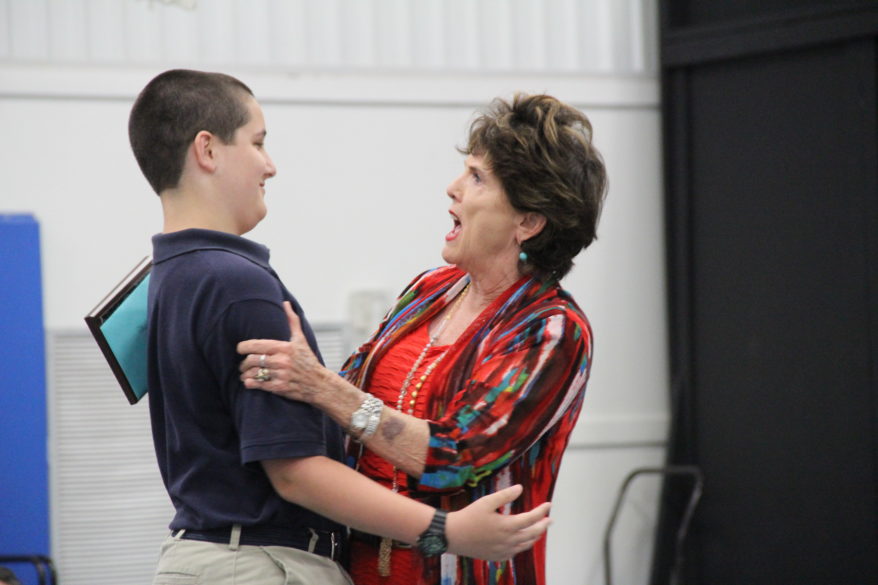
(Photos by Katie Fenstermacher)
St. Richard school performance


(Photos by Tereza Ma)
Changing out crops in Southaven






By Maureen Smith
JACKSON – Wanda Thomas, the new CEO for Catholic Charities of Jackson, is no stranger to the agency or the good work being done there. She is set to start Monday, June 17. Thomas worked as a therapist at Charities in the early 2000s and has gone on to earn more credentials and more experience both in social work and the supervision of that work at other agencies in the state.
Thomas spent many years at Canopy Children’s Services, formerly known as Mississippi Children’s Home Services, as a regional director, director of intensive in-home services and program director of their therapeutic foster care services. Catholic Charities has similar programs.
“I have a passion and drive for change. I like to see change over time. I like to look at where we have come from. I like to build things. The services and programs (at Catholic Charities) are there, but as the new person I can come in with new thoughts and new ideas and think outside the box,” said Thomas. “I am looking forward to adding to what is already in place and having a positive impact,” she added.
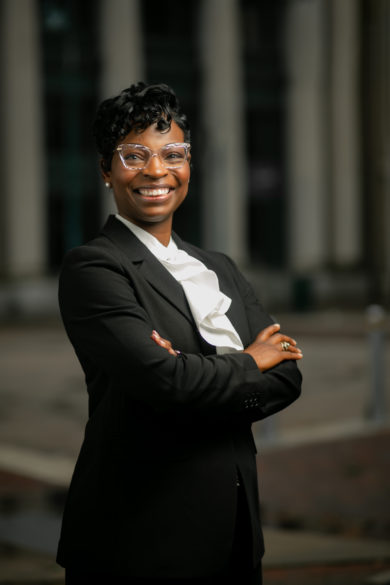
Msgr. Elvin Sunds, former executive director for Catholic Charities, was on the search committee for a new leader. “She has 20-some years of experience in social work. She is a licensed master social worker, which is important to the agency. She has supervised programs similar to the ones offered at Catholic Charities. She is certainly qualified,” said Msgr. Sunds. “The committee was impressed with her enthusiasm, her communication skills and her commitment to the mission of Catholic Charities,” he explained.
Thomas describes herself as very mission driven. The mission of Charities, she said, is one of the reasons she felt called to apply for the position. She believes her experience will help her in her new role because she has faced many of the challenges facing the staff already in place. “That’s going to give me a great opportunity and window into what we may need to improve on, what we are missing, but I have also been in their shoes. I have had to come up with solutions to many of these challenges,” she said.
“I want to strengthen what we already have in place – highlight what we are doing well. (I want to focus on) retention. You can only be as successful as your staff, so I want to retain talented individuals, to recruit, to provide them with development to do their best jobs. I want them to teach me how to work alongside them. To me, I am building a whole new team,” she said.
Thomas said when therapists and staff members work with people in crisis or people who have experienced trauma, they can carry part of those burdens with them. “I want to restore hope, in a way. What they are doing is having an impact. I want them to see that impact. When you can show how they are being beneficial, that can be a motivator,” said Thomas. “The health of an agency and its culture carries out into the community,” she added.
For the past three years, Bishop Joseph Kopacz has acted as CEO for the agency in collaboration with John Lunardini, the Agency’s COO for the past year and a half. “I am most grateful to John Lunardini for his invaluable contribution to the wellbeing of the agency through the strengthening of our financial base, our relationships with our funding sources and the advancement of our marketing and development. For sure, he will bring his skills and added experience from the social service world to any future employment,” Bishop Kopacz said.
Thomas will be the first non-Catholic at the helm of the agency. The bishop plans to remain present to direct the Catholic identity efforts at the office, and to further strengthen the vital role that Catholic Charities has for the diocesan mission and vision, but will hand the day-to-day operations over to Thomas. “Wanda Thomas has a great sense of what our mission needs to be, and we will move forward with a great team,” said the bishop.
Charities was formally chartered in 1963, but has its roots in the founding of a pair of orphanages in Natchez in the 1850s. It currently operates a number of social service programs including therapeutic foster care, adoption, the Solomon Counseling Center, services for the survivors of domestic violence, refugee and migrant support services and services for families experiencing mental health crises.
By Gene Buglewicz
Simon Quiriconi and Cristian Costa, artists from Stagi Masaici Artistici in Pietrasanta, Italy, recently completed installing a glass mosaic on the south face of St. John the Evangelist Church in Oxford. The mosaic was created in their Italian studio where they produced and crafted thousands of pieces of colored glass that would complete the mosaic.
The mosaic was first laid out face down, backside up. A composite material, similar to paper with glue attached was spread over the glass pieces. After drying, contour lines were drawn over the paper material dividing the mosaic into pieces. It was then divided into pieces following the contour lines and packed for shipment to the United States. After arriving in Oxford, the boxes were unloaded and the mosaic re-constructed, again, face down.
It took only three days to complete the project once the Italian artists arrived in Oxford and began work. They first laid out the mosaic on the floor and made sure the lines on the back of the mosaic all matched and fit together like a puzzle. The large pieces of mosaic were then pressed onto the front niche on the outside of the Church and the mosaic took shape. The glass surface, now permanently exposed to the outside and bonded to the church, was smeared with grout, similar to grouting bathtub tile. After drying, the glass pieces were cleaned. Final plans call for the mosaic to be permanently lit at night.
The mosaic is a depiction of St. John the Evangelist. He is shown on a rocky landscape which is representative of Patmos where he composed the Book of Revelation. John is typically shown as either a clean-shaven young man or a bearded old man. The mosaic portrays John as he is maturing, which is representative of the role the parish plays as students at the University of Mississippi begin to mature in their faith.
St. John is shown wearing the colors of blue and red, which are not only the colors of the University of Mississippi but the colors associated with the Divine Mercy; Spirit and Water. The eagle is his attribute and seen flying across a night sky. Although the eagle is not a night predator, the use of night and the bright moon acknowledge the themes of darkness and light which play out in John’s Gospel.
The mosaic was a gift to St. John the Evangelist Catholic Church from Knights of Columbus Council 10901 of St. John. This depiction of St. John was created by Lee Ann O’Keefe, a member of St. John’s Parish, and facilitated by Catholic Supply of St. Louis, Missouri.
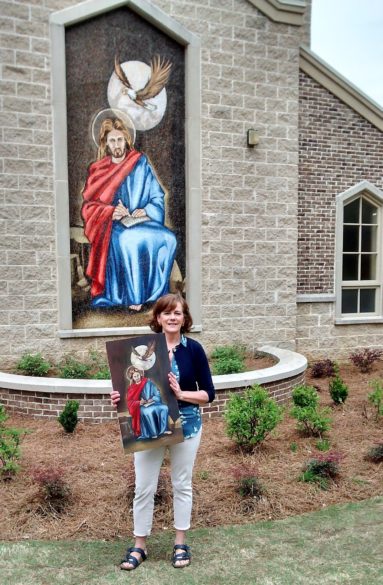
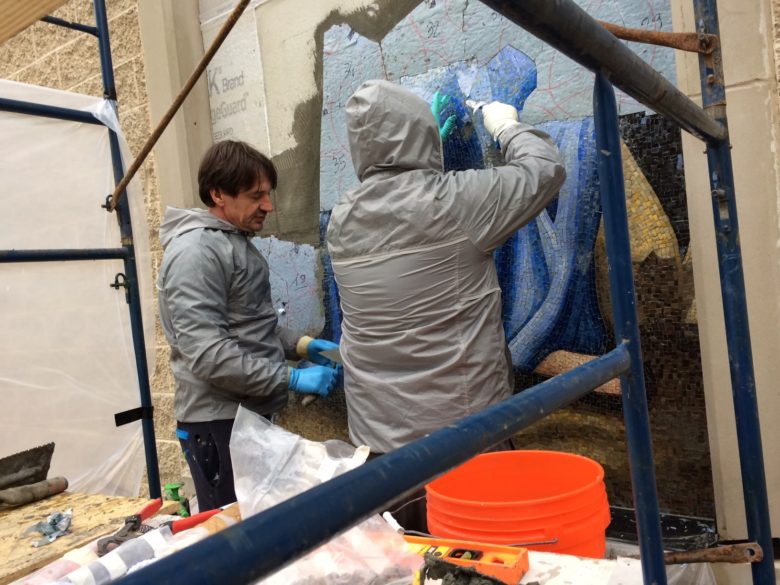
JACKSON – Claude W. Harbarger, FACHE, has informed St. Dominic’s leadership, medical staff and employees of his intention to retire as the President of St. Dominic Health Services, Inc. (SDHS or St. Dominic’s) effective June 30, after having served the St. Dominic’s organization for the past 32 years.
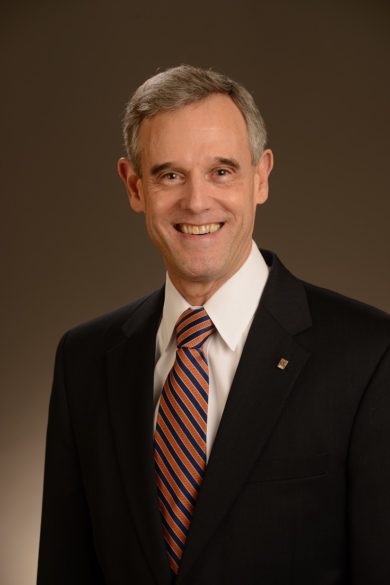
Harbarger’s decision corresponds with St. Dominic’s transition of sponsorship to the Franciscan Calais Ministries and the Franciscan Missionaries of Our Lady Health System (FMOLHS) on July 1.
“After thoughtful deliberation, I believe the timing of this decision will best facilitate St. Dominic’s positioning into the FMOLHS organizational structure,” Harbarger said. “The decision has been made in full and cordial collaboration with the Dominican Sisters, the SDHS Board of Directors and the leadership of FMOLHS.”
Lester K. Diamond, who serves as President of St. Dominic Hospital, will also begin serving as President of St. Dominic Health Services on July 1. In this expanded role Diamond will participate as a member of the executive and operating leadership team for FMOLHS. He joins CEOs from each of the FMOLHS ministry markets who are likewise supported by the system in implementing the health system’s strategic plan, prioritizing operational excellence and leading integration and growth.
“I have personally enjoyed getting to know both Claude and Lester in their experiences with FMOLHS over the past years, including as members of our Board,” Richard R. Vath, MD, Interim President and CEO of FMOLHS, said. “I want to add my thanks to Claude for his selfless service to Catholic health care and the many contributions he has made at St. Dominic’s. He is a tremendous leader. We are looking forward to Lester’s new role as he brings insights and experiences to our Franciscan ministry and continues the important legacy of St. Dominic’s for families in Mississippi.”
Harbarger joined St. Dominic’s in 1987 as Senior Vice President–Professional Services. He was named President of St. Dominic Hospital in 1991 – a position he held 20 years. He was named President of St. Dominic Health Services on January 1, 2012, following Dominican Sister M. Dorothea Sondgeroth’s retirement from the position.
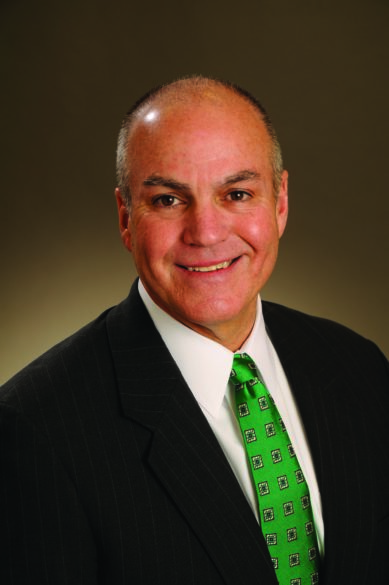
Harbarger began his administrative career in 1978 at Humana Hospital Augusta, Georgia. His professional activities include fellowship in the American College of Healthcare Executives. He currently serves as a member of the Greater Jackson Chamber Partnership Board of Directors, the Mississippi True Board of Directors and on multiple committees of the Mississippi Hospital Association.
Harbarger is a member of First Presbyterian Church where he serves as an Elder. He and his wife Karis reside in the Jackson area and have three married children and seven grandchildren.
Diamond, who was born in Jackson at St. Dominic Hospital, pursued his undergraduate studies at Memphis State University in Business Administration, and his graduate studies at the University of Mississippi in Health Care Administration. He completed his administrative residency at Eastwood Hospital in Memphis, Tenn. in 1984.
Diamond began his administrative career in 1985 with Charter Medical Corporation as an Assistant Administrator and ultimately served in this position at Charter Peachford Hospital in Atlanta, Georgia and Charter Plains Hospital in Lubbock, Texas, where he also served as the Human Resource Director.
In 1988, Diamond accepted the position of Chief Operating Officer at Laurelwood where he was responsible for directing the daily operations of all clinical programs and ancillary services.
Diamond joined St. Dominic Hospital in 1992 as Vice President for the North Campus. Diamond was then named Vice President of Behavioral Health Services and also held administrative responsibilities for the Jackson Mental Health Center.
In 1996, Diamond transitioned to the position of Vice President of Professional Services, with responsibility for many of the hospital’s ancillary departments. In 1997, he was promoted to Senior Vice President of Professional Services and was then promoted to Executive Vice President of Operations in 2007. He succeeded Claude W. Harbarger as President of St. Dominic Hospital on January 1, 2012, when Harbarger was promoted to president of St. Dominic Health Services.
Diamond serves on the board of the Mississippi Hospital Association, where he is the current Chairman. In addition, he serves on executive boards for the Mississippi Housing Partnership, Mississippi Health Partners and Vizient Southern States.
The Diamond family attends St. Richard Catholic Church. Diamond and his wife Gina live in Jackson, Mississippi and have two sons, Andrew and Eric.
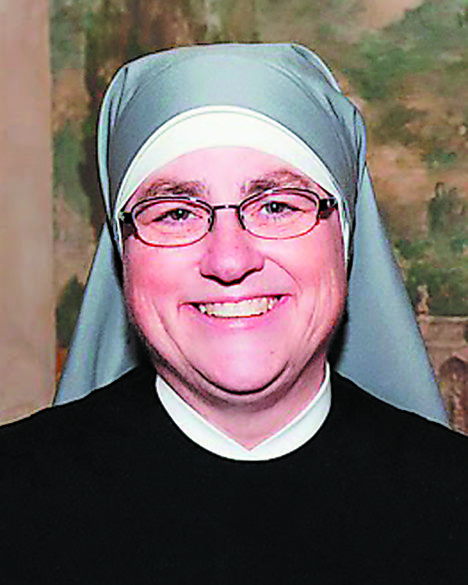
GUEST COLUMN
By Sister Constance Veit, l.s.p.
My fondest memories of summer are the times spent with my favorite aunt at her cottage nestled in the Adirondack Mountains. As a middle school teacher, she had a gift for relating to kids in a way very different from parents, like a wise friend or a trusted confidante. My aunt patiently taught us how to knit and sew; she listened to our stories and nurtured our dreams as if each niece or nephew were the only one.
She took us on long walks in the woods, pointing out her favorite wildflowers and teaching us to recognize fresh bear tracks and other potential dangers. She also taught us how to paddle her antique canoe around the nearby lake. As we got older, my aunt would sit on the dock reading a book as we took the canoe out to explore the lily pads along the shoreline or ride the waves created by the speeding motorboats. But she always kept one eye on us in case we got into trouble.
Although she never had children of her own, my aunt took a lively interest in all her nieces and nephews until the very end of her life. She never gave us lectures, expressed disapproval or told us how things should be done, but she always kept an eye on us. She remained creative and curious long after retiring and unassumingly shared her time, her talents and herself with others.
As I read Pope Francis’ recent post-synodal letter, Christus Vivit, in which he encourages the young and the old to form strong bonds, I realized what a blessing my aunt was to our family, for she personified the ideal of elders as wisdom figures and memory keepers.
“What do I ask of the elders among whom I count myself?” our Holy Father wrote. “I call us to be memory keepers … I envision elders as a permanent choir of a great spiritual sanctuary, where prayers of supplication and songs of praise support the larger community that works and struggles in the field of life. It is a beautiful thing when “young men and maidens together, old men and children, praise the name of the Lord” (Ps 148:12- 13).
When her life was coming to an end my aunt felt she had very little to leave us, but as my siblings and cousins came from all over the country to bid her farewell, it was obvious that because she had given us so much of herself, she would live on and even blossom in us.
“What can we elderly persons give to the young?” Pope Francis asked in Christus Vivit. “We can remind today’s young people, who have their own blend of heroic ambitions and insecurities, that a life without love is an arid life…. We can tell fearful young people that anxiety about the future can be overcome…. We can teach those young people, sometimes so focused on themselves, that there is more joy in giving than in receiving, and that love is not only shown in words, but also in actions.”
This is what my aunt taught us!
The following words of our Holy Father brought her memory to life in a special way:
“During the Synod, one of the young auditors from the Samoan Islands spoke of the Church as a canoe, in which the elderly help to keep on course by judging the position of the stars, while the young keep rowing, imagining what waits for them ahead.” He concluded, “Let us all climb aboard the same canoe and together seek a better world, with the constantly renewed momentum of the Holy Spirit.”
So, this summer, be intentional about bringing the generations in your family or neighborhood together. Take time for long walks and slow canoe rides, and for sharing memories and dreams. You won’t be disappointed!
(Sister Constance Veit is director of communications for the Little Sisters of the Poor.)
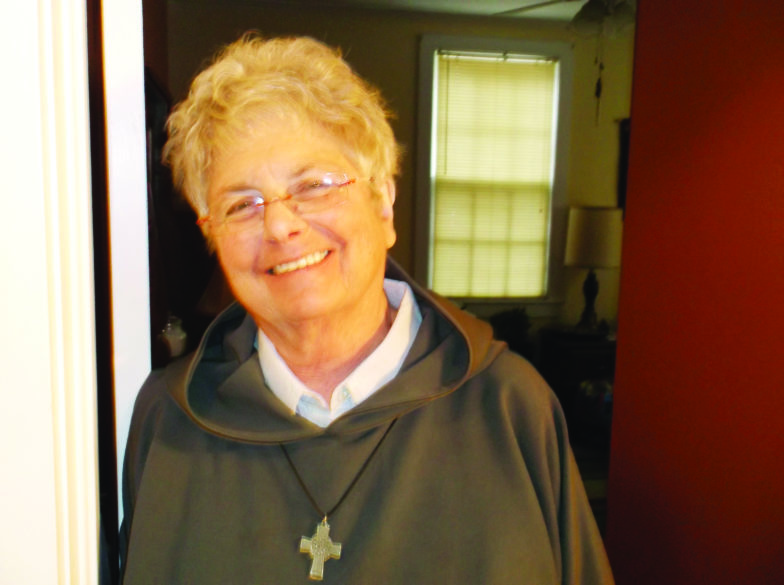
FROM THE HERMITAGE
By Sister therese alies
“I had no plan, I just met people and people with disabilities awoke my heart.” So spoke Jean Vanier one day when being asked how L’Arche communities began and how they had grown.
Sometimes our lives are blessed with meeting or being near special persons. One of the things that makes someone special is that they reveal to us something of the truth about ourselves, maybe our inner beauty, some gift or even our struggles to live an authentic life. I was blesed to have had this experience. Sometimes even fleeting moments or short-extended stays, or a retreat venue is just enough to turn one’s life ever more deeply into a more loving discipleship.
On Wednesday, May 7, Jean Vanier, died. He was 90 years old and for the last 50 or so years devoted himself to the handicapped, disabled and those with intellectual disabilities all around the world. Often people with various handicaps are not welcome in their own homes, the parents feeling it is their fault or not having the proper support to raise a special needs child.
Jean was a young naval officer who left the Canadian navy to ‘follow Jesus.’ He did academic work and was a college professor. One summer he went to a small village in France and studied with a Dominican priest and a few other fellows like himself. They spent the summer visiting the local ‘asylums’ and God spoke deeply to his heart. He went out and bought a small cottage and invited the first two men into his home. Neither could speak and both had severe disabilities. Jean had never been trained how to help the handicapped. He just felt called to live with them. This was the founding of L’Arche Communities in 1964.
Now there are more than 154 communities in 39 countries where folks with a variety of disabilities are welcomed for life, living with those whose handicaps (don’t we all have them?) are less visible or debilitating. Some assistants who come as sort of ‘midwives’ to help others grow to maturity will live with core members for a year or two. Some much longer. Folks living in L’Arche communities are welcomed into a rich life of relationships, the very thing Jean writes, in his more than 30 books, are at the heart of our deepest need. This includes a deep faith life for those who wish. Though Catholic, communities are made up of folks from every culture and religion. Closest to us in the South are the communities in Atlanta, Jacksonville, Mobile and St. Louis.
Jean made sure to quote Dorothy Day when told he was a ‘living saint.’ She quipped near the end of her life “Don’t call me a saint. I don’t want to be dismissed that easily!” Of course, she is indeed now a Servant of God. I suspect he will be too.
Jean and Dorothy were both people of the Way – those who took seriously the many messages of Jesus, especially those calling us to service of the most vulnerable. Pope Francis has reminded us of the ‘peripheries’ more than once. Perhaps as the Canadian writer and former L’Arche member Carolyn Whitney-Brown reminds us ”he is an icon, not an idol.”
Some 40 years ago I was pleased to be a small part of the Tahoma Hope L’Arche community in Tacoma, Washington. David Rothrock, one of the founders, reminds us, “There are not many people who become internationally acclaimed because they treasure weakness and vulnerability”
Probably Jean’s best international bestseller is Becoming Human. The book is actually five talks he gave for the Massey Lectures commissioned by Massey College of the University of Toronto and broadcast on the Canadian Broadcast show, Ideas.
The first of Jean’s seven aspects of love is reveal. “To reveal someone’s beauty is to reveal their value by giving them time, attention, and tenderness. To love is not just to do something for them but to reveal to them their own uniqueness, to tell them that they are special and worthy of attention … this revelation heals … the belief in the inner beauty of each and every human being is at the heart of L’Arche … as so as we start selecting and judging people instead of welcoming them as they are — with their sometimes hidden beauty, as well as their more frequently visible weaknesses — we are reducing life, not fostering it. When we reveal to people our belief in them, their hidden beauty rises to the surface where it may be more clearly seen by all.” Thank you, Jean, for sharing the gift God entrusted to you for the good of us all. Rest in peace.
BLESSINGS.
(Sister alies therese is a vowed Catholic solitary who lives an eremitical life. Her days are formed around prayer, art and writing. She lives and writes in Mississippi.)
By Junno Arocho Esteves
VATICAN (CNS) – Too often when Catholics try to talk to young people about vocational discernment, “it’s as if we were speaking Esperanto to them, because they don’t understand a thing,” Pope Francis said.
Bishops, pastors, religious and other adults must learn to speak young people’s language and must avoid exercising undue pressure on young men and women to enter a seminary or join a religious order, the pope said June 6 at a gathering of people doing vocations work in Europe.
With the advent of new technologies and social media, he added, young people today know how to contact others, “but they do not communicate.” “Communicating is perhaps the challenge that we have with young people,” the pope said. “Communication; communion; we must teach them that computers are good, yes; to have some form of contact, but this isn’t language. This is a ‘gaseous’ language. The true language is to communicate, to speak.”
Participants in the Congress for the Pastoral Care of Vocations in Europe were in Rome to study ways to implement the recommendations made during the Synod of Bishops on young people and vocational discernment in October.
Departing from his prepared speech, the pope said he preferred to speak “a bit off the cuff with what comes from my heart.”
Citing the words of Pope Benedict XVI, Pope Francis said the “church grows through attraction, not proselytism” and recalled a time when several Italian religious orders went to the Philippines in the early 1990s to search for vocations to bring back to Italy.
Seeking vocations “isn’t about looking where to take people like those nuns” who would “go there and brought girls here,” he said. “I wanted to clear this up because the spirit of proselytism hurts us.” Instead, the church must help young people learn how “to dialogue with the Lord” and how to ask him, ‘What do you want from me?’”
“This is important, it is not an intellectual conviction,” the pope said. “No, the choice of a vocation must be born from dialogue with the Lord, no matter what their vocation is.”
Young people, he said, must be helped to get to the point where they can say, “The Lord inspires me to go forward this way in life, on this path.” Pope Francis said helping young people discern their vocation is tiring work and requires “so much patience and a great capacity to listen.”
“It isn’t easy, it isn’t easy, but you can’t go forward with preconceived notions or purely doctrinal impositions, in the good sense of the word: ‘You must do this!’” the pope said. “No, you must accompany, guide and help so that the encounter with the makes them see what their path in life is.”
(Follow Arocho on Twitter: @arochoju)
IN EXILE

By Father Ron Rolheiser, OMI
During the years that I served as a Religious Superior for a province of Oblate Priests and Brothers in Western Canada, I tried to keep my foot inside the academic world by doing some adjunct teaching at the University of Saskatchewan. It was always a once-a-week, night course, advertised as a primer on Christian theology and drew a variety of students.
One of the assigned readings for that course was Christopher de Vinck’s book, Only the Heart Knows How to Find Them: Precious Memories for a Faithless Time. The book is a series of autobiographical essays, most of which focus on his home life and his relationship to his wife and children. The essays describing his relationship to his wife don’t overplay the romantic, but are wonderfully heart-warming and set sex into a context of marriage, safety and fidelity.
At the end of the semester a young woman, 30 years old, said this to me as she handed in her term paper, a reflection on de Vinck’s book: “This is the best book I’ve ever read. I didn’t have a lot of moral guidance growing up and so I wasn’t always careful with my heart and was pretty free and existential about sex. I’ve basically slept my way through two Canadian provinces; but now I know that what I really want is what this man (de Vinck) has. I’m looking for the marriage bed!” Her eyes teared as she shared this.
I’m looking for the marriage bed! That’s a great image for what the heart calls home.
At the end of the day, what is home? Is it an ethnic identity, a gender, a citizenship, a house somewhere, the place where we were born or is it a place in the heart?
It’s a place in the heart and the image of the marriage bed situates it well. Home is where you are comfortable, physically, psychologically and morally. Home is where you feel safe. Home is where your heart doesn’t feel out of place, compromised, violated, denigrated, trivialized or pushed aside (even if it is sometimes taken for granted). Home is a place which you don’t have go away from to be yourself. Home is where you can be fully yourself without the need to posture that you are anything other than who you are. Home is where you are at ease.
There are various lessons couched inside that concept of home, not least, as this young woman came to realize, some valuable insights apposite how we think about love and sex. Some of what’s at stake here is captured in the popular notion of longing for a soulmate. The trouble though is that generally we tend to think of a soulmate in very charged romantic terms. But, as de Vinck’s books illustrates, finding a soulmate has more to do with finding the moral comfort and psychological safety of a monogamous marriage bed than it has to do with the stuff of romantic novels. In terms of our sexuality, what lies deepest inside our erotic longings is the desire to find someone to take us home. Any sex from which you have to go home is still something which is not delivering what you most long for and is, at best, a temporary tonic which leaves you searching still for something further and more real.
The phrase, I’m looking for the marriage bed, also contains some insights vis-a-vis discerning among the various kinds of love, infatuation and attractions we fall into. Most people are by nature temperamentally promiscuous, meaning that we experience strong feelings of attraction, infatuation and love for all kinds of others, irrespective of the fact that often what we are attracted to in another is not something we could ever be at home with. We can fall in love with a lot of different kinds of people, but what kind of love makes for a marriage and a home? Marriage and home are predicated on the kind of love that takes you home, on the kind of love that gives you the sense that with this person you can be at home and can build a home.
And, obviously, this concept doesn’t just apply to a husband and wife in marriage. It’s an image for what constitutes home – for everyone, married and celibate alike. The marriage bed is a metaphor for what puts one’s psychological and moral center at ease.
T.S. Eliot once wrote: Home is where we start from. It’s also where we want to end up. At birth our parents bring us home. That’s where we start from and where we are at ease until puberty drives us out in search of another home. Lots of pitfalls potentially await us in that search, but if we listen to that deep counsel inside us, that irrepressible longing to get home again, then like the wise magi who followed a special star to the manger, we too will find the marriage bed – or, at least, we won’t be looking for it at all the wrong places.
(Oblate Father Ron Rolheiser, theologian, teacher and award-winning author, is President of the Oblate School of Theology in San Antonio, TX.)
(Editor’s note: Bishop Joseph Kopacz is at the USCCB meeting in Baltimore this week and was thus unable to contribute a column. His regular column will return in the next paper.)
By Julie Asher
WASHINGTON (CNS) – When the bishops gather in Baltimore starting June 11, Bishop W. Shawn McKnight of Jefferson City, Missouri, said he’s “hopeful we will have some progress made in moving the football” on the church’s response to the abuse crisis by approving several proposals to hold the bishops accountable.
“I think the recent new norms from Holy Father will make it more possible, but I am waiting to see and I will be fully involved in the debate,” he told Catholic News Service June 7.
The centerpiece of the bishops’ agenda will be four action items dealing with the investigation of abuse claims against bishops themselves or accusations they have been negligent in handling or covering up cases of wayward priests and other church workers.
These proposals were before the bishops at the fall general assembly last November, but the Vatican requested they delay action on them until after the Vatican held a February meeting for presidents of bishops’ conferences worldwide to discuss the abuse crisis.
The norms Bishop McKnight referenced are contained in Pope Francis’ “motu proprio,” released May 9 and in effect as of June 1. The document, titled “Vos estis lux mundi” (“You are the light of the world”), is a new universal law from the pope to safeguard its members from abuse and hold its leaders accountable. It governs complaints against clergy or church leaders regarding the sexual abuse of minors or vulnerable persons. The U.S. bishops will vote on directives for implementing this church law.
The full texts of the pope’s “motu proprio” and the U.S. Conference of Catholic Bishops’ “Charter for the Protection of Children and Young People,” as well as the new reforms to be discussed in Baltimore, are available on a new website the USCCB launched June 7: www.usccbprevention.org.
The pope’s new juridical instrument calls for a “public, stable and easily accessible” reporting system for allegations; clear standards for the pastoral support of victims and their families; timeliness and thoroughness of investigations; whistleblower protection for those making allegations; and the use of “proven experts from among the laity;” and the oversight of the metropolitan (archbishop) for such investigations in his province. The U.S. Catholic Church has 32 metropolitans.
Under each archdiocese are dioceses, also called suffragan sees, for which a metropolitan is responsible.
“For me the critical element in the effort to respond to the crisis is the necessity of lay involvement,” Bishop McKnight told CNS. “I am grateful the document allows for the metropolitan to use lay experts.”
Just as dioceses have a lay board to assess allegations against priests and other church workers, the same lay-led review is needed for bishops for two reasons, Bishop McKnight said. “First, for transparency to build credibility in the process so people know it is not just miters and collars but mothers and fathers (looking at these allegations) as well.”
“Second, as a bishop myself, if there was ever a false allegation made against me, I would want an independent lay assessment of the investigation to build credibility (in the finding) that the claim is not credible.”
Two other prelates interviewed by CNS ahead of the bishops’ spring assembly, Bishop Edward J. Weisenburger of Tucson, Arizona, and Archbishop Alexander K. Sample of Portland, Oregon, also strongly emphasized the need for lay involvement in reviewing claims against bishops.
“I cannot imagine there not being a majority of lay involvement,” Bishop Weisenburger said June 7. “The current model of diocesan review boards owes a substantial part of their success to the fact that they are lay-led and lay-driven. That fact is not lost on any bishop.”
In the Tucson Diocese, “we have had tremendous success in working with our Diocesan Review Board,” he noted.
“I feel certain that my brother bishops will strive to create regional lists of experts that are composed in majority of lay experts in the fields of law, law enforcement, psychology, education, canon law and social work,” Bishop Weisenburger added.
Said Archbishop Sample: “Clearly the cry for more lay involvement is not just among laity but priests and bishops (too). … For my part, I will do everything I can – and I am just one bishop among many – to ensure that there will be an adequate role for the laity to be involved in these investigations within these church processes. The ‘motu proprio’ certainly opens the door (to this).”
“Quite honestly I hope this is one of the areas we can strengthen. … I hope we will be able to enshrine within our own (structures) an active and significant role for the laity,” he said.
Going into the assembly, “my hopes and expectations are optimistic,” the archbishop added, “I wouldn’t say super-high but I’m very optimistic the bishops will be able to complete next week what we tried to begin at our November meeting in light of the new ‘motu proprio,’ (which is) further guidance on what we should be doing to take responsibility for this crisis in the church and respond to it.”
“I hope that there will be some good modifications and amendments to the documents” he said, to strengthen them especially with regard to “transparency and accountability, the two words that resonate most with me right now going into this meeting.”
The bishops must have effective protocols that enable them to hold each accountable, which is “really what Christ asks of us as shepherds of the church,” Archbishop Sample said. “We also need accountability before the people of God.”
As for the proposal for metropolitan oversight, the archbishop said that as metropolitan himself, he takes this charge “extremely seriously.”
“I think the Holy Father’s intention in the ‘motu proprio’ he issued is that the church use her own structures which are already in place to really address these issues in a significant way, and the role of the metropolitan archbishops is a grave responsibility,” he said.
Since the November meeting, when the metropolitan “option” surfaced, “I’ve given it a lot of reflection and I’m overwhelmed a little bit to receive this responsibility … and I pledge that I will do everything I can do to ensure there is full accountability in my realm of influence,” Archbishop Sample said.
“To the eyes of some it looks like the bishops are investigating themselves again and that this is what has gotten us into this mess in the first place,” he remarked.
However, it is important for people “to know and understand” that “using the church’s own structures is what the Holy Father intends,” he explained, and the church’s way of dealing with allegations – “within the church law and structures” – is carried out “without any prejudice” to civil authorities doing their own investigation.
“Both of these tracks have to run parallel, because in the end the church still has to deal with the status” of its own members, he said. “We need our own structure to deal with them” but this does not “hamper” what civil authorities must do on these abuse cases.
Bishop Weisenburger called the metropolitan option “an excellent model.”
“On the one hand it’s true to our history, who we are as a hierarchic church,” he said. “On the other hand, it’s a somewhat new adaptation which I think will allow general principles of investigation to be applied in a healthy local manner. The time limits related to the various steps are especially helpful as it prevents a critical investigation from being delayed.”
When he looks at his region, whose metropolitan is the archbishop of Santa Fe, New Mexico, he said: “I trust that we have a wealth of experts who could come together and undertake an investigation in a timely and professional manner. I think something good for the church is unfolding before us.”
Last fall, when the Vatican asked the bishops’ to postpone voting on these critical abuse protocols, many felt the church was just stalling on the need to address issues of the hierarchy’s accountability, but Bishop Weisenburger feels “the November delay proved beneficial.”
“There was tremendous pressure for the bishops to create an immediate response to the situation – I felt that pressure myself – but in retrospect I’m not sure we make the best decisions when we move that fast,” he told CNS. “I think the Vatican summit helped clarify some of the critical issues. I now think it’s time for the U.S. bishops to come to a consensus on a procedure that can be undertaken easily when a report needs to be made about an allegation against a bishop.”
Bishop McKnight told CNS the laity in his diocese have given him “a consistent message” about the abuse scandal in listening sessions he has held, both this spring in preparation for his “ad limina” report to Rome and last fall ahead of the bishops’ November meeting: That message is to “get it all out now,” rather than this piecemeal approach to revelations about abuse, past or present.
One of his big questions about the McCarrick scandal, he said, is why haven’t members of the hierarchy “who were knowledgeable and complicit in his promotion” just come forward on their own and take responsibility?
“This does not require an investigation or special adjustment of canon law,” Bishop McKnight said. “I understand and feel the frustration of the laity.”
(Follow Asher on Twitter: @jlasher)